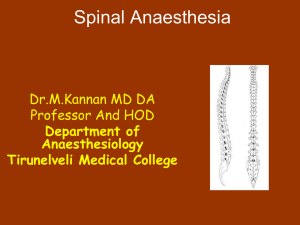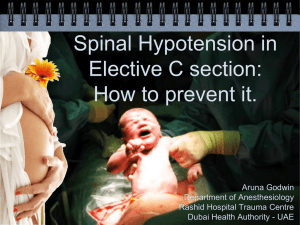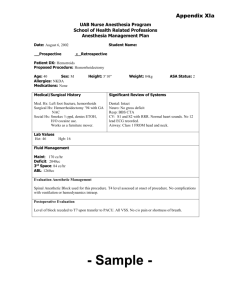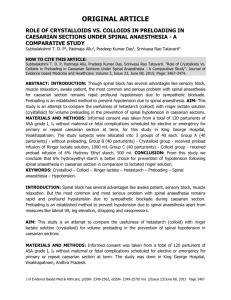introduction
advertisement
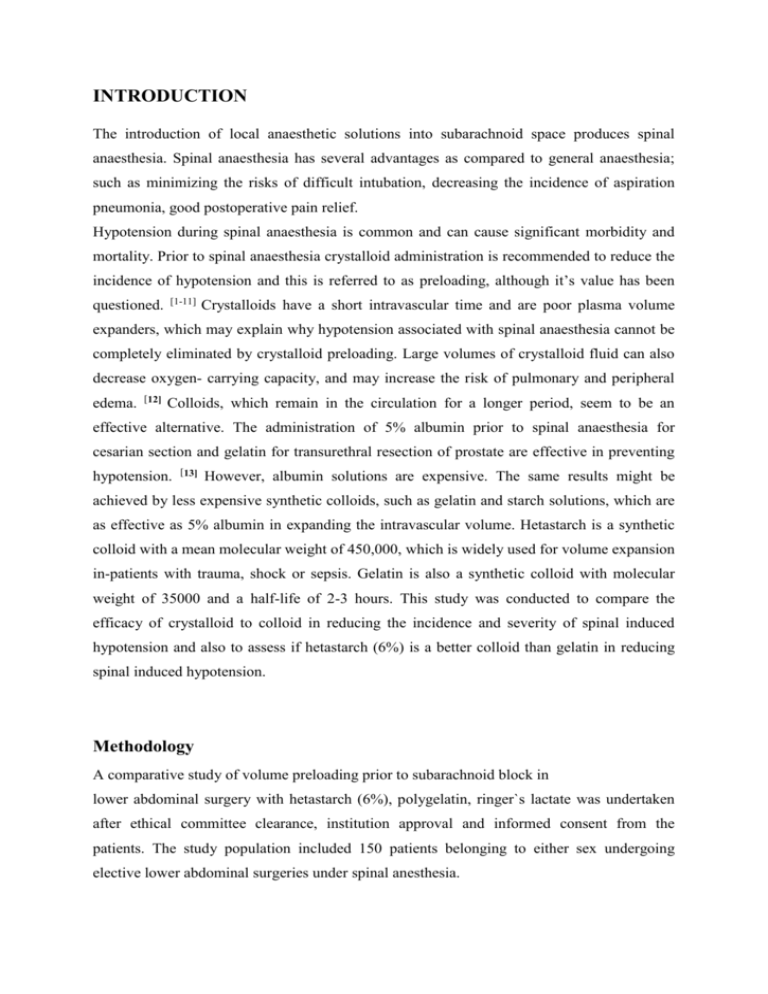
INTRODUCTION The introduction of local anaesthetic solutions into subarachnoid space produces spinal anaesthesia. Spinal anaesthesia has several advantages as compared to general anaesthesia; such as minimizing the risks of difficult intubation, decreasing the incidence of aspiration pneumonia, good postoperative pain relief. Hypotension during spinal anaesthesia is common and can cause significant morbidity and mortality. Prior to spinal anaesthesia crystalloid administration is recommended to reduce the incidence of hypotension and this is referred to as preloading, although it’s value has been questioned. [1-11] Crystalloids have a short intravascular time and are poor plasma volume expanders, which may explain why hypotension associated with spinal anaesthesia cannot be completely eliminated by crystalloid preloading. Large volumes of crystalloid fluid can also decrease oxygen- carrying capacity, and may increase the risk of pulmonary and peripheral edema. [12] Colloids, which remain in the circulation for a longer period, seem to be an effective alternative. The administration of 5% albumin prior to spinal anaesthesia for cesarian section and gelatin for transurethral resection of prostate are effective in preventing hypotension. [13] However, albumin solutions are expensive. The same results might be achieved by less expensive synthetic colloids, such as gelatin and starch solutions, which are as effective as 5% albumin in expanding the intravascular volume. Hetastarch is a synthetic colloid with a mean molecular weight of 450,000, which is widely used for volume expansion in-patients with trauma, shock or sepsis. Gelatin is also a synthetic colloid with molecular weight of 35000 and a half-life of 2-3 hours. This study was conducted to compare the efficacy of crystalloid to colloid in reducing the incidence and severity of spinal induced hypotension and also to assess if hetastarch (6%) is a better colloid than gelatin in reducing spinal induced hypotension. Methodology A comparative study of volume preloading prior to subarachnoid block in lower abdominal surgery with hetastarch (6%), polygelatin, ringer`s lactate was undertaken after ethical committee clearance, institution approval and informed consent from the patients. The study population included 150 patients belonging to either sex undergoing elective lower abdominal surgeries under spinal anesthesia. Inclusion Criteria • ASA physical status class 1 and 2. • Age between 25 and 70 years. • Weight between 40 and 70 Kg. Exclusion Criteria • Emergency surgeries. • Severe anaemia, coagulation abnormalities and bleeding disorders. • Patients with previous history of surgeries on the spine. • Patients with spinal deformities. • Patients with active skin lesions over lumbosacral region. • Patients with obesity, chronic hypertension, diabetes, and heart disease. A thorough pre-anaesthetic evaluation was done with special emphasis on cardiorespiratory, nervous system and endocrinal abnormalities. A thorough general and systemic examination was carried out for baseline vital parameters, airway assessment, cardiorespiratory and CNS abnormalities. Height and weight were recorded. Patients were kept nil oral as per ASA guidelines and informed consent was obtained. Patients were randomized (computer generated number) into 3 groups of 50 patients each: • Group A: Patients receiving preloading with 10ml/kg of hetastarch (6%). • Group B: Patients receiving preloading with 10ml/kg of polygelatin. • Group C: Patients receiving preloading with 10ml/kg of ringer`s lactate. Patients were transported to O. T where 18G canula were inserted. Standard monitoring included heart rate (HR), electrocardiogram (ECG), non-invasive blood pressure (NIBP) and oxygen saturation (SpO2). Baseline heart rate, systolic blood pressure, diastolic blood pressure and mean arterial pressure were recorded. The fluids were administered prior to spinal anesthesia over duration of 15 minutes. After intravascular administration, all vitals were measured. With all aseptic conditions and patients in lateral position, spinal anaesthesia was performed at L3-L4 interspace with a 25 gauge spinal needle using 3ml of 0.5% bupivacaine heavy .The patient was turned to supine position, and the level of anaesthesia determined by pinprick method, bilaterally, after 10 minutes of intrathecal injection. Heart rate, SBP, DBP, MAP were recorded at 2-min intervals for the first ten minutes and every five minutes for 1-hour duration. Hypotension was defined as decrease in MAP to less than 75% of the baseline value. Hypotension was treated by an intravenous bolus of 6mg mephentermine repeated as necessary until the blood pressure was increased to >75 % of the baseline value. Bradycardia (heart rate less than 50/min) when encountered was treated with 0.6 mg of atropine. After preloading all patients were given ringer lactate at the rate of 1.5 ml/Kg/hr as maintenance fluid. The number of patients developing hypotension as well the mean dose of mephenteramine required for treatment was noted. Statistical Methods The analysis of variance was carried out to find the group significance difference of HR, SBP and MAP between the three groups of patients. The Post hoc test by Tukey was carried out to find the pair wise significance between the three groups. The Chi-square test was used to find the significance of proportions of mephentermine dose requirement between the three groups. Results One hundred and fifty patients undergoing lower abdominal surgeries under spinal anaesthesia were divided into three groups, group A, B and C of 50 each. The demographic variables such as age, sex, weight, baseline vitals were comparable between the three groups (Table 1). Anaesthesia was adequate in all the patients and there was no need for supplementation. Level of block was between T6 and T10 in all the three groups. Blood loss was minimal in all the patients. Table 2 and figure I shows the incidence of hypotension observed in the study. In the group A incidence of hypotension was 18% as compared to 34% and 54% in groups B and C respectively. Table 3 and figures 2 show the trend of change in mean arterial pressure change in the three groups. It can be seen that there is no significant change in MAP in the three groups in the first two minutes after spinal anesthesia. In the 4th, 6th, and 8th minute interval after spinal, it can be seen that group C had a significant fall in MAP when compared to group A. (p=0.025), (p=0.005), (p<0.001). In the 10th minute interval after spinal, it can be seen that group C had a greater fall n MAP when compared to group A which was statistically significant (p<0.001). Group C also had a statistically significant fall when compared to group B (p=0.029). In the 15th minute interval, it can be seen that group A had a statistically significant lesser fall in MAP when compared to groups C and B (p<0.001) (p=0.029). Similarly group B had lesser fall when compared to group C (p=0.06). In the 20th, 30th, and 35th minute interval after spinal, group C had a statistically significant fall in MAP when compared to group A (p=0.001), (p=0.027), (p=0.048). There was no statistically significant difference between group A and group B. Figure 3 show the requirements of mephentermine boluses in treating hypotension. In group A, out of fifty patients only nine patients required treatment with mephentermine and no patients required a repeat bolus. In group B, a total of seventeen patients required mephentermine. In addition one of them required a repeat dose of mephentermine. When compared to the first two groups, in group C, 54% of the patients required treatment with mephentermine. Twenty-two patients were treated with a single bolus dose of mephentermine whereas five patients required an additional bolus. Chi-square was used to test if there was any significance among the three groups. It was shown that the findings were statistically significant. Group A was better in terms of lesser requirement of mephentermine boluses to treat hypotension in comparison to the other two groups. Group B required lesser doses when compared to group C. It can be inferred from the above that HES prevents hypotension better than polygeline and ringer lactate. DISCUSSION Spinal anaesthesia is the more commonly administered procedure for pelvic, lower abdominal and lower limb procedures. It is popular because of simplicity and reliability of the technique as well as the relative rapidity with which adequate anesthesia can be established. In contrast to general anesthesia, it avoids poly-pharmacy as well as situations of difficult intubation. Satisfactory analgesia for abdominal surgeries under spinal block requires sensory block from T6 to S5. This level of high thoracic block induces widespread vasodilatation with resultant hypotension. A significant number of patients suffer from disturbing hypotension and relative hypovolemia during this procedure. Many authorities suggest that crystalloid preloading is not effective in reducing the incidence of hypotension after spinal anaesthesia [9-11] as 75% of the infused fluid diffuses into interstitial spaces, and it’s efficacy in expanding plasma volume is only transient. Mathru et al [13] has previously shown that intravascular administration of 50% albumin is more effective than intravascular crystalloid administration. Attempts to correct the hypotension with crystalloid solutions may result in large volumes of infusion [14], which can be hazardous for the individual. Furthermore it has been observed that the infusion of even a small amount of crystalloid such as one liter of normal saline increases the closing volume and decreases the dynamic compliance of the lungs. Theoretically, a colloid solution is the more logical choice in preventing hypotension since it remains in the circulation for a longer period because of its oncotic pressure. Hydroxyethyl starch being hyperoncotic, has the ability to withdraw fluid from interstitial into intravascular space. Extent of volume expansion is 150%. Polygelatin is isooncotic, has a mean half-life of 4- 5 hours. In our study we randomized 150 patients into three groups with 50 patients each. Group A received 10ml/kg of HES, group B received 10 ml/kg of polygeline, group C received 10 ml/kg of Ringer`s lactate. Patients receiving HES and polygeline had a lower incidence of hypotension when compared to ringer lactate. Group A patients had a incidence of 18% of hypotension, group B had a incidence of 34% whereas ringer lactate group had the maximum incidence of hypotension of 54%. Also the mean dose of mephentermine required was less in the colloid groups compared to the ringer lactate group. Group A patients required a mean dose of 1.08 mg, group B a mean dose of 2.16 mg and group C a mean dose of 4.08 mg which was statistically significant. These findings are consistent with the findings of others who have compared colloid and crystalloid preloading prior to spinal anesthesia. A study by Sharma et al [15] has shown that intravenous infusion of 500 ml of 6% hetastarch is more effective than 1000 ml of lactated Ringer`s solution in attenuating spinal anesthesia induced hypotension in women undergoing postpartum tubal ligation. Incidence of hypotension was 52% in the lactated Ringer`s solution and 16% in the hetastarch group. Karinen et al [16] study in 1995 aimed to compare the effect of Ringer`s lactate and hydroxyethyl starch preloading on the hemodynamic state during spinal anesthesia on patients undergoing cesarean section. The study showed high incidence of maternal hypotension in the crystalloid (62%) group as compared to the colloid group (38%). In our study the incidence of hypotension in ringer lactate group was 54% and it was 18% in the hydroxyethyl group. Baraka et al study [17] in 1994 compared intravascular administration of polymerized gelatin and isotonic saline before spinal anesthesia for prevention of spinal anesthesia induced hypotension. They reported an 11% incidence of hypotension after administration of 7 ml/kg of 3% gelatin compared with 52% after same volume of crystalloid in males undergoing transurethral resection of prostate under spinal anaesthesia. Shapira et al [18] study in 1991 aimed to determine different aspects concerning hypotension and its prevention following spinal anesthesia by preloading the patients with haemaccel and ringer`s lactate. They found that the systolic blood pressure decrease was significantly greater in the crystalloid group. The average decrease in systolic blood pressure in the haemaccel group was 6 mm hg and in the ringer group it was 16 mmHg. M.P.Vercauteren et al (1996) 19] studied 90 patients undergoing elective cesarean section under spinal anaesthesia who received ringer lactate (LR) 1000 ml with upto 1000 ml of modified gelatin, LR 1000 ml with upto 1000 ml of hydroxyethyl starch 6%(HES) or only upto 1000 ml of 6% HES. Lumbar puncture was performed as soon as 500 ml of the colloid was infused. The incidence of hypotension, number of patients requiring a vasopressor and doses of ephedrine required to restore arterial pressure were significantly lower in favour of those receiving the crystalloid – HES combination. In our study group A received HES and group B received polygelatin. The incidence of hypotension was 18% in group A and 34% in the polygeline group. Also the mean dose of mephentermine required was significantly less in the HES group. Riley et al (1995) [20] conducted a study to determine whether preoperative administration of 6% hydroxyethyl starch decreases the incidence and severity of hypotension after spinal anaesthesia for elective caesarian section. Forty non laboring ASA grade I and II women having non urgent caesarian section were randomized to receive either 500 ml of 6% HES plus one liter of ringer lactate (n=20), or two liter of ringer lactate prior to induction of spinal anaesthesia. Hypotension occurred in 45% of patients who received HES Vs 85% of those who received only ringer lactate (p< 0.05) and minimum systolic blood pressure was lower in the ringer lactate group than in the HES group. In addition, the ringer lactate group had a higher maximum heart rate, a shorter mean time to hypotension and required more 5 mg doses of ephedrine for treatment of hypotension than HES group. They concluded that 6% of HES plus ringer lactate is more effective than ringer lactate alone. In our study we measured the hemodynamic variables - heart rate, systolic blood pressure, diastolic blood pressure and mean arterial pressure. The baseline values were not significantly different in the three groups. There was an increase in the pulse rate immediately after preloading and upto 25-30 minutes after spinal anesthesia in all the three groups, though statistically not significant. The SBP increased to about three to five mm hg after preloading in all the three groups with no statistical significance. The fall in SBP to less than 100 mm of hg after spinal block was as early as six minutes in the ringer lactate group whereas in the other two groups the SBP was maintained to a significantly longer time. The same trend was observed when MAP was taken into consideration. Colloids are known to cause anaphylactoid reactions and hypotension is an important feature of this reaction along with rash and bronchospasm. In our study apart from two patients in the polygelatin group developing a transient itching there was no other adverse effects. The increase in plasma oncotic pressure produced by colloid helps draw fluid into the intravascular space and thereby expands the plasma volume and remains in the intravascular space for a long time. This effect counteracts the hypovolemia caused by spinal anesthesia. About 75 to 80% of any crystalloid solution given diffuses into the interstitial space within 15 to 20 minutes, while 75% of the colloid remains largely within the intravascular space for a longer period. Our present study confirms that the colloids offset hypotension and hypovolemia more effectively than crystalloids in patients scheduled for elective surgery under spinal anesthesia and also that hydroxyethyl starch may be a better colloid than polygelatin in preventing hypotension. CONCLUSION It can be concluded from the present study that colloids offset hypotension and hypovolemia more effectively than crystalloids in patients scheduled for elective lower abdominal surgery under spinal anesthesia. Also it can be concluded that hydroxyethyl starch is a better colloid than polygelatin in preventing spinal anesthesia induced hypotension. REFERENCES 1. Rout. C. C, Akoojee. S. S, Rocke. D.A, Gouws; Rapid administration of crystalloid preload does not decrease the incidence of hypotension after spinal anesthesia for elective cesarean section. BJA 1992; 68: 394-397. 2. Coe. A.J, Revanas. U.B; is crystalloid preloading useful in elderly? Anesthesia 1990; 45: 241-243. 3. Hallworth. D et al; Hypotension during epidural anesthesia for cesarean section, a comparison of intravenous loading with colloid and crystalloid. Anesthesia 1982; 37: 53-56 4. Murray. A.M et al; Crystalloid versus colloid for circulatory preload for cesarean section. Anesthesia 1989; 44: 463-66. 5. Rout. D.A, Rocke; Volume preloading, Spinal hypotension and cesarean section. BJA 1995; 75: 257-259. 6. Critchley. C.A and Conway F; Hypotension during spinal anesthesia, hemodynamic effects of colloid and metariminol. BJA 1996; 76: 734-736. 7. Jackson. R, Reid. J.A, Thorburn. J; Volume preloading is not essential to prevent spinal induced hypotension at cesarean section. BJA 1995; 75: 262-265. 8. Veroli. P, Benhamax. D; Comparison of hypertonic saline, isotonic saline and ringer lactate solution for fluid preloading before lumbar epidural block. BJA 1992; 69: 461-64. 9. Bassell, Gerard. M, Marx, Gertie F, Rocke, Rout; Intravenous preload in prevention of spinal induced hypotension in parturients. Anaesthesiology 1994; 80: 702-704. 10. Rout, Rocke, Levin, Gouws, Reddy; A re-evaluation of the role of crystalloid preload in the prevention of hypotension associated with spinal anesthesia for elective cesarean section. Anaesthesiology 1993; 79: 262-269. 11. Rout, Chris, Rocke, D. Antoun; Spinal hypotension associated with cesarean section; will preload ever work? Anaesthesiology 1999; 91: 1565-70. 12. Phillip O. Bridenbaugh, Nicholas M. Greene, Sorin J. Brull. Spinal Neural blockade. In: Michael J cousins, Phillip O. Bridenbaugh ed. Neural blockade in Clinical Anesthesia and Management of Pain. Third edition. Philadelphia: Lippincott Raven, 1998: 203- 241. 13. Mathru M, Rao TLK, Kartha RK et al. Intravenous albumin administration for prevention of spinal hypotension during Cesarean section. Anesth Analg 1980; 59; 653-658. 14. Robson. S et al, Changes in cardiac output during epidural anesthesia for cesarean section. Anesthesia 1989; 44: 475-479. 15. Sharma SK, Gajraj NM, Sidwai JE. Comparison of hypotension during spinal anesthesia: A comparison of Hetastarch versus lactated Ringer`s solution. Anesth Analg 1997; 84; 111 114. 16. Karinen J, Rasanen J, Alahuhta S, Jouppila R, Jouppila P. The effect of crystalloid and colloid preloading on uteroplacental and hemodynamic state during spinal anesthesia for cesarean section. Br J Anesth. 1995; 75; 531-535. 17. Baraka AS, Taha SK, Ghabach MB et al. Intravascular administration of polymerized gelatin versus isotonic saline for prevention of spinal induced hypotension. Anesth Analg 1994; 78; 301-305. 18. Shapira S.C et al. A comparison of intravenous loading for epidural with ringer lactate and polygeline. European Journal of Pain, 1991; 12: 100-103. 19. Vercauteren MP, Hoffmann V, Coppejans HC, Van Steenberge AC, Adriansen HA. HES compared with modified gelatin as volume preload before spinal anesthesia for cesarean section. Br J Anesth 1996; 76; 731-733. 20. Riley ET, Lohen SE, Rubenstein AJ, Flanagan B. Prevention of hypotension after spinal anesthesia for cesarean section: Six percent hetastarch versus lactated Ringer`s solution. Anesth Analg 1995; 81; 838-842. Table 2: Incidence of hypotension Figure 1: Incidence of hypotension Table 3 Figure 2: Graphical view of MAP Table 4 Figure 3: Graphical view of mephentermine dose requirements
